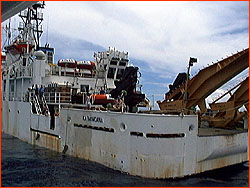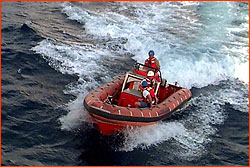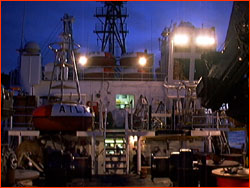
|

|

|
Sanctuary from the Perfect Storm February 26, 1998 By Mark Hoover previous | next  I'm back from the Galapagos, and still squeezing the last of
the tropical dispatches from my El Nino-pickled-computer
before I attempt to hit the road one last time—for a
final flight investigating the jet stream.
I'm back from the Galapagos, and still squeezing the last of
the tropical dispatches from my El Nino-pickled-computer
before I attempt to hit the road one last time—for a
final flight investigating the jet stream. On the afternoon of February 19, despite the swollen and red condition of my sleepless eyes, I was the first to spot NOAA's research ship, the Ka'imimoana. "There she is!" I proclaimed to my torporous shipmates, none of whom looked particularly well-rested. I was referring to a tiny speck about four atoms high occasionally bobbing on the very limit of the horizon, and I was roundly accused of hallucination. "Drink some water, deegital man," suggested Fernando. "You are dehydrated. If we can't get them on the radio, I don't think you can see them." We'd had a lot of problems communicating with the Ka'imimoana over the Orca's radios, which seemed to have caught the same saltwater sickness my computer contracted three days earlier. All this business with the compasses and sextants and navigation maps and frequency bands on the marine radio was getting a little old, anyway. The Ka'imi was rumored to have air conditioning, and this alone drove me in my battle with the sea. So I grabbed the fish bucket and the satphone, and...called the Ka'imi. Yup, they were about 12 miles away, right on the horizon. Had the A/C set to 68, too. Fernando was impressed. "Hey deegital man...think I could use that thing to call my broker?" We approached the Ka'imi about an hour later, and they sent a motor launch over to bring us aboard. About 220 feet long, the Ka'imi is a recent acquisition of NOAA's, a converted submarine surveillance ship the Navy built about ten years ago, and gave up after the breakup of the USSR. It is a handsome and trim vessel, totally reconfigured to support deployment and recovery operations for the TOGA/TAO buoy array, the world's first-line El Niño detection system and a powerful ocean observation instrument that lets scientists on shore watch changes in the tropical Pacific as they happen, across the entire ocean basin from South America to Australia (see Advance Warning). The Ka'imi spends about 250 days a year cruising between the mooring sites for the buoys in the array, covering tens of thousands of miles of ocean at a steady ten knot clip. Its crew of twenty-five or thirty (depending on the number of scientists on board) spends up to two months without ever seeing land. Our scientist in residence on this voyage, Mike McPhaden, has logged many a nautical mile on the Ka'imi, and as we approached her, he was subtly transformed. It was a pleasure to watch him board her, walk her decks, greet the crew. The Ka'imi is Mike's turf. He had come home. This is where his science happens.  After our film crew loaded its gear, we prepared to observe
buoy recovery and deployment operations scheduled for this
evening and tomorrow. The buoy that was supposed to be on
station here went missing last December, after having moved
(the crew said "walked") about 20 miles from its original
location. Whether it was snagged in a fishing boat's nets, or
swept by a strong ocean current, we'll never know. Its anchor,
with an acoustic cable release and communications device,
responded from the seafloor miles below to a query from the
ship's hydrophone, but the buoy was nowhere to be seen. Mike
says vandalism by fishermen is a problem in the eastern
Pacific, but there's really not much that can be done about
it.
After our film crew loaded its gear, we prepared to observe
buoy recovery and deployment operations scheduled for this
evening and tomorrow. The buoy that was supposed to be on
station here went missing last December, after having moved
(the crew said "walked") about 20 miles from its original
location. Whether it was snagged in a fishing boat's nets, or
swept by a strong ocean current, we'll never know. Its anchor,
with an acoustic cable release and communications device,
responded from the seafloor miles below to a query from the
ship's hydrophone, but the buoy was nowhere to be seen. Mike
says vandalism by fishermen is a problem in the eastern
Pacific, but there's really not much that can be done about
it.The next day, after a real shower, sleep in an actual bed, and a couple of very square meals, I realize I...kind of miss the Orca. As Fernando said, I'm probably dehydrated. Anyway, it was a very rough night on the sea, and even the Ka'imi was rolling heavily. I thought a lot about the uncomplaining crew of the Orca, and the time they must have been having coping with the waves, a half mile behind the Ka'imi. Although the Orca is not the first choice for a deep-sea cruiser, it is actually a good boat for travelling around the Galapagos, and its crewmembers spend about 90% of their lives aboard her. There is something vaguely romantic in such a life. I thought about all of this, and then got out of my chair to turn the air conditioner up another notch.  It rained and blew all day, but both the ship's crew and the
film crew carried on, oblivious to the elements. The work of
deploying a buoy is physically demanding, and requires heavy
equipment and adherence to safety procedures. First, the
anchor and its acoustic coupler must be readied, and the
mooring line attached. Three miles or more of special nylon
cable must be fastened and played out as the anchor descends,
which takes hours. Then, the metal cable which contains
sensors along the last 1,500 feet must be hand-braided to the
nylon, and over the side it goes. Finally, the buoy itself,
having been prepped and calibrated the day before, is hoisted
into the water, and the cable attached. (You don't want to
"let go of the rope" at this point.) Finally, the buoy's
communications with the overhead satellite is tested, and the
instruments get one last test as well. The whole process,
depending on weather, takes four to eight hours. And then it's
on to the next site, hundreds of miles away.
It rained and blew all day, but both the ship's crew and the
film crew carried on, oblivious to the elements. The work of
deploying a buoy is physically demanding, and requires heavy
equipment and adherence to safety procedures. First, the
anchor and its acoustic coupler must be readied, and the
mooring line attached. Three miles or more of special nylon
cable must be fastened and played out as the anchor descends,
which takes hours. Then, the metal cable which contains
sensors along the last 1,500 feet must be hand-braided to the
nylon, and over the side it goes. Finally, the buoy itself,
having been prepped and calibrated the day before, is hoisted
into the water, and the cable attached. (You don't want to
"let go of the rope" at this point.) Finally, the buoy's
communications with the overhead satellite is tested, and the
instruments get one last test as well. The whole process,
depending on weather, takes four to eight hours. And then it's
on to the next site, hundreds of miles away.Late in the day, we made the decision to brave the storm and leave the Ka'imi, so I'm gathering up my things—including the dramamine—and I'll be back on my tiny bunk in the hold of the Orca in about an hour, sweating and trying to type on a notebook computer with a keyboard that looks like a prop from Land of the Giants. We've got a 40-hour cruise back to the Galapagos, for a visit to Porto Ayoro and the Darwin Research Station, and then we're outta here, and back to real life. Wow. previous dispatch | next dispatch | table of contents Anatomy of El Niño | Chasing El Niño | El Niño's Reach Dispatches | Resources | Mail | Site Map | El Niño Home Editor's Picks | Previous Sites | Join Us/E-mail | TV/Web Schedule About NOVA | Teachers | Site Map | Shop | Jobs | Search | To print PBS Online | NOVA Online | WGBH © | Updated November 2000 |